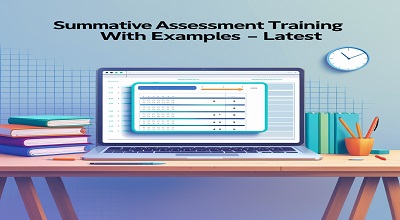Summative Assessment Training
Summative Assessment Training: Summative assessments are evaluations conducted at the end of a learning period to measure students’ understanding, knowledge, and skills. Unlike formative assessments, which provide ongoing feedback, summative assessments are typically high-stakes and used for grading or certification purposes.
These assessments play a crucial role in education by helping educators determine whether learning objectives have been met. Common examples include final exams, standardized tests, and end-of-term projects.
Purpose and Importance of Summative Assessments
Summative assessments serve multiple purposes:
- Evaluating Student Learning: They provide a clear measure of what students have learned.
- Curriculum Alignment: Ensure teaching methods align with learning outcomes.
- Accountability: Help institutions maintain educational standards.
- Certification: Used for diplomas, degrees, and professional qualifications.
Without summative assessments, it would be difficult to gauge long-term retention and mastery of subjects.
Types of Summative Assessments
There are various forms of summative assessments, including:
- Standardized Tests (SAT, GRE, State Exams)
- Final Exams (End-of-Term or End-of-Year Tests)
- Cumulative Projects (Research Papers, Presentations)
- Performance-Based Assessments (Lab Experiments, Art Portfolios)
- Benchmark Assessments (District or National Comparisons)
Each type serves a unique purpose in evaluating student performance.
MCQs on Summative Assessment
1. What is the primary purpose of summative assessment?
A) To provide ongoing feedback
B) To evaluate learning at the end of a course
C) To guide instructional adjustments
D) To encourage peer learning
2. Which of the following is NOT a summative assessment?
A) Final exam
B) Weekly quiz
C) End-of-term project
D) State standardized test
3. How does summative assessment differ from formative assessment?
A) It is conducted during learning
B) It focuses on final evaluation rather than feedback
C) It is always informal
D) It does not contribute to grading
4. Which technology is commonly used in modern summative assessments?
A) Online proctored exams
B) Handwritten essays only
C) Oral recitations
D) Group discussions
5. What is a key challenge in summative assessments?
A) They provide instant feedback
B) They may cause student stress
C) They are always easy to design
D) They are never used for certification
Conclusion
Summative assessments are essential for measuring long-term learning outcomes. By understanding their purpose, types, and best practices, educators can design effective evaluations that enhance student success. For more teacher training resources, visit TeacherEducator.com.
